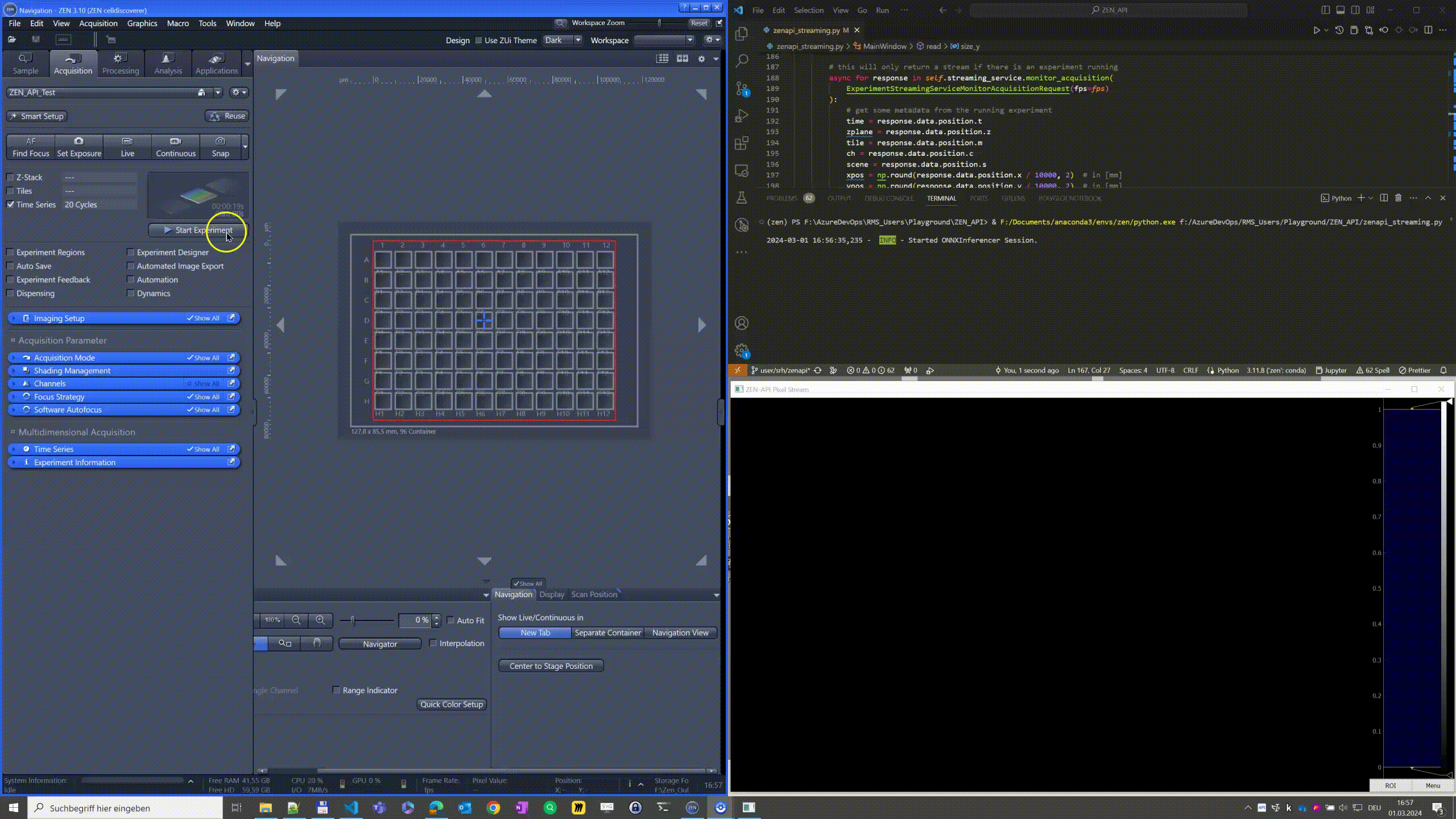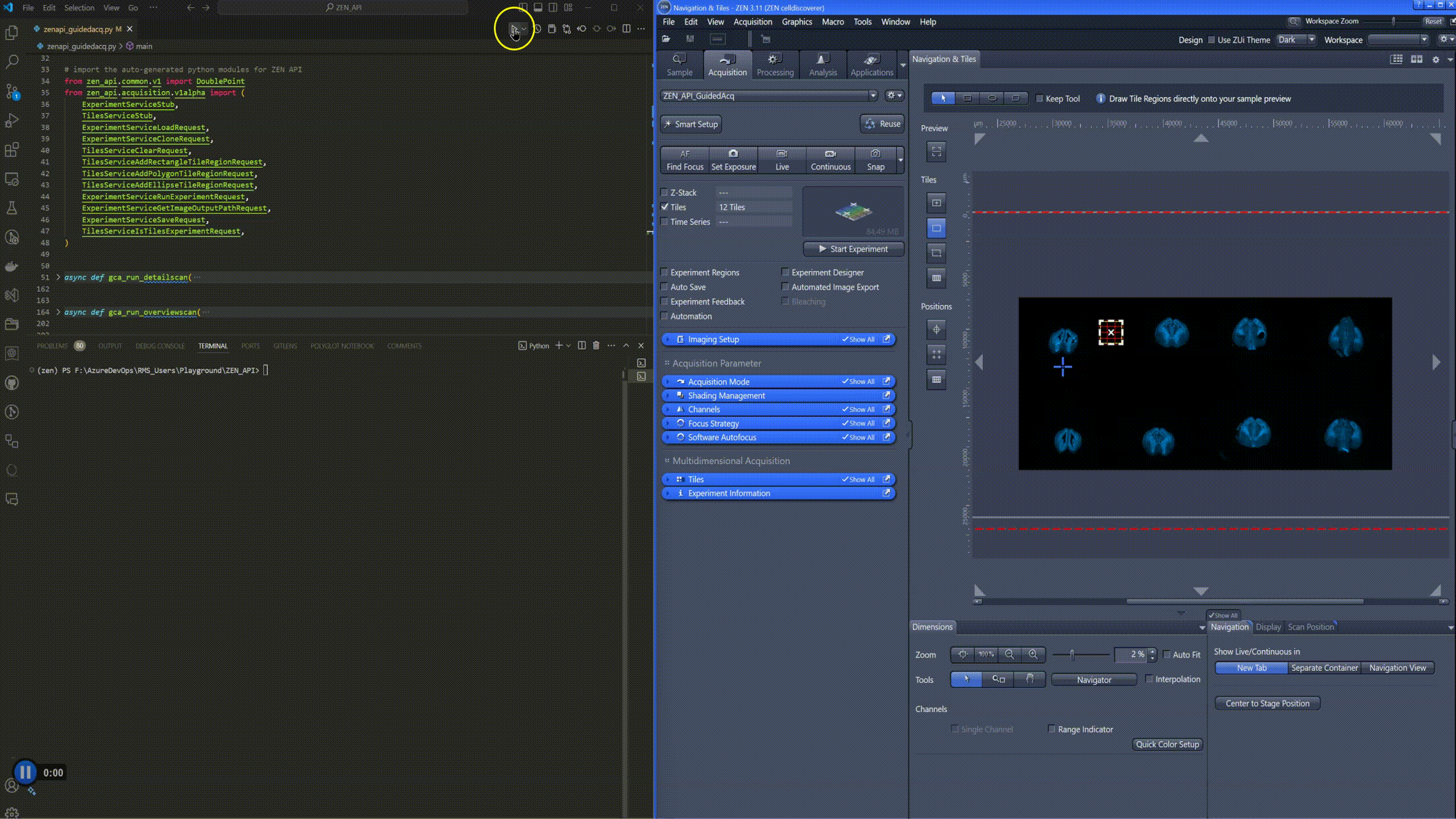- Smart Microscopy On-site Workshop: From Zero to Hero with ZEN and Open-Source Tools
- Disclaimer
- General Remarks
- Prerequisites
- ZEN API
- Deep Learning Topics
- Train a Deep-Learning Model for Semantic Segmentation on arivis Cloud
- Use the model in your python code
- Train your own model and package (as *.czann) using the czmodel package
- Train a simple model for semantic segmentation
- Train a simple model for regression
- Use the model inside Napari (experimental)
- Using the czitools package (experimental)
- CZICompress - Compress CZI image files from the commandline
- CZIShrink - Compress CZI image files from a cross-platform UI
- CZICheck - Check CZI for internal errors
- napari-czitools (experimental)
- CZI and OME-ZARR (experimental)
- Useful Links
This content of this repository is free to use for everybody and purely experimental. The authors undertakes no warranty concerning the use of those scripts, image analysis settings and ZEN experiments, especially not for the examples using 3rd python modules. Use them on your own risk.
By using any of those examples you agree to this disclaimer.
This repository contains scripts and notebooks showcasing several tools and scripts centered around ZEN, CZI image files, deep-learning models and related python packages.
- Download and install Miniconda if needed: Download Miniconda
- Install Jupyter & Co
conda activate base
conda install jupyterlab jupyter_server nb_conda_kernelsTo run the notebooks locally it is recommended to create a fresh conda environment. Please feel free to use the provided YML file (at your own risk) to create such an environment:
conda env create --file env_smartmic.ymlImportant: If one wants to test the labeling & training directly on arivis Cloud or create a module it is required to have an account.
To use Colab one needs to have a Google account.
To test and run an arivis Cloud module locally one needs Docker Desktop installed.
All examples can be found at: ZEN API Examples - ZEN Blue 3.12
ZEN running an acquisition while the PixelStream is processed by a python client. For the code can be found at: zenapi_streaming.py
ZEN running a simple "guided acquisition" where the overview image is analyzed using python. Subsequently all found objects are acquire automatically. For the code can be found at: zenapi_guidedacq.py
The general idea is to learn how to label a dataset on arivis Cloud.
Dataset Name: Smart_Microscopy_Workshop_2025_Nucleus_Semantic
- label some nuclei "precisely"
- label background areas and edges
- embrace the idea of partial labeling
- start a training to get a trained model as a *.czann file
Remark: The the modelfile: cyto2022_nuc2.czann can be found inside the repository.
For more detailed information please visit: Docs - Partial Annotations
Once the model is trained it can be downloaded directly to your hard disk and used to segment images in ZEN or arivis Pro or your own python code.
Train your own model and package (as *.czann) using the czmodel package
The package provides simple-to-use conversion tools to generate a CZANN file from a PyTorch or ONNX model that resides in memory or on disk to be usable in the ZEN, arivis Cloud, arivisPro software platforms and also in your own code.
For details and more information examples please go to: czmodel
This plugin is purely experimental. The authors undertakes no warranty concerning its use.
In order to use such a model one needs a running python environment with Napari and the napari-czann-segment plugin installed.
It can install it via pip:
pip install napari-czann-segmentFor more detailed information about the plugin please go to: Napari Hub - napari-czann-segment
Using the czitools package (experimental)
This python package is purely experimental. The authors undertakes no warranty concerning its use.
For details please visit: czitools
Starting with ZEN 3.9 ZSTD (Z-Standard) will be the new default compression method in ZEN (it was already available longer), but obviously there are already many existing CZI image files "out there" and how to deal with existing ZEN installations that can read uncompressed CZIs but not compressed CZIs?
Therefore we created a command line tool:
- compress or decompress a single CZI file
- versatile
- scriptable
- run in headless/server environments
- run in cron jobs
- cross-platform (focus on linux-x64 and win-x64)
- public Github repository: CZICompress
Start the executable from the command line, providing the required command line arguments.
Usage: czicompress [OPTIONS]
Options:
-h,--help Print this help message and exit
-c,--command COMMAND
Specifies the mode of operation: 'compress' to convert to a
zstd-compressed CZI, 'decompress' to convert to a CZI
containing only uncompressed data.
-i,--input SOURCE_FILE
The source CZI-file to be processed.
-o,--output DESTINATION_FILE
The destination CZI-file to be written.
-s,--strategy STRATEGY
Choose which subblocks of the source file are compressed.
STRATEGY can be one of 'all', 'uncompressed',
'uncompressed_and_zstd'. The default is 'uncompressed'.
-t,--compression_options COMPRESSION_OPTIONS
Specify compression parameters. The default is
'zstd1:ExplicitLevel=0;PreProcess=HiLoByteUnpack'.
Copies the content of a CZI-file into another CZI-file changing the compression
of the image data.
With the 'compress' command, uncompressed image data is converted to
Zstd-compressed image data. This can reduce the file size substantially. With
the 'decompress' command, compressed image data is converted to uncompressed
data.
For the 'compress' command, a compression strategy can be specified with the
'--strategy' option. It controls which subblocks of the source file will be
compressed. The source document may already contain compressed data (possibly
with a lossy compression scheme). In this case it is undesirable to compress the
data with lossless zstd, as that will almost certainly increase the file size.
Therefore, the "uncompressed" strategy compresses only uncompressed subblocks.
The "uncompressed_and_zstd" strategy compresses the subblocks that are
uncompressed OR compressed with Zstd, and the "all" strategy compresses all
subblocks, regardless of their current compression status. Some compression
schemes that can occur in a CZI-file cannot be decompressed by this tool. Data
compressed with such a scheme will be copied verbatim to the destination file,
regardless of the command and strategy chosen.SET PATH=$PATH;C:\Users\y1mrn\Downloads\czicompress
cd /D D:\TestData
czicompress --command compress -i LLS-31Timepoints-2Channels.czi -o compressed.cziexport PATH=$PATH:/c/Users/y1mrn/Downloads/czicompress
cd /d/TestData
find -type f -name '*.czi' -not -iname '*zstd*' -exec czicompress.sh '{}' \;- Cross Platform GUI App
- Developed, tested and released on Win-x64 and Linux-x64
- Designed to work with large CZI collections
- Multi-threaded processing
- Strictly non-destructive
- Developed still as a private repo on GitHub => release as OSS planned soon
[CZICheck] is a command-line application developed using libCZI, enabling users to assess the integrity and structural correctness of a CZI document.
Checking the validity of a CZI becomes more complex the closer one is to the application domain (e.g. application-specific metadata). So this console application is more of a utility to help users who are directly using libCZI, or its python wrapper pylibCZIrw & pylibCZIrw_github, than it is an official validation tool for any ZEISS-produced CZIs.
CZICheck runs a collection of checkers which evaluate a well defined rule. Each checker reports back findings of type Fatal, Warn, or Info.
Please check the tool's internal help by running CZICheck.exe --help and check additional documentation on the repository.
This plugin is purely experimental. The authors undertakes no warranty concerning its use.
In order to use such a model one needs a running python environment with Napari and the napari-czitools plugin installed.
It can install it via pip:
pip install napari-czitoolsFor more detailed information about the plugin please go to: Napari Hub - napari-czitools
All OME-ZARR related scripts here are purely experimental. The authors undertakes no warranty concerning the use of those scripts.
By using any of those examples you agree to this disclaimer.
Convert CZI to OME-ZARR using ome-zarr
See: write_omezarr_adv.py
Convert CZI to OME-ZARR using ngff-zarr
See: write_omezarr_adv.py
Convert CZI to OME-ZARR HCS Plate using ome-zarr
See: write_omezarr_adv.py
Convert CZI to OME-ZARR HCS Plate using ngff-zarr
See: write_omezarr_adv.py
| Name/Description | Link | Name/Description | Link |
|---|---|---|---|
| Napari - Python-based image viewer | GitHub | pip - Python Package Installer | PyPI |
| PyPi - Python Package Index | PyPI | pylibCZIrw - Python Package to read & write CZI files | PyPI |
| pylibCZIrw - GitHub Repository for CZI files (Python) | GitHub | czmodel - Package for Pytorch & ONNX models | PyPI |
| cztile - Python Package for tiling arrays | PyPI | arivis Cloud - DL Training Platform | arivis Cloud |
| napari-czann-segment - Napari Plugin for DL models | GitHub | napari-czitools - Plugin for CZI files | GitHub |
| CZI - Carl Zeiss Image Format | ZEISS | PyTorch | PyTorch |
| ONNX | ONNX | libCZI - GitHub Repository for CZI files (C++) | GitHub |
| czitools - Tools for CZI files | PyPI | Colab | Colab |
| Docker Desktop | Docker Desktop | CZICompress - Shrink CZI files | GitHub |
| CZIChecker - Check Integrity of CZI files | GitHub | ome-zarr - Python Implementation of NGFF Specs | GitHub |
| NGFF - Next-generation File Formats | NGFF | ngff-zarr - Python Implementation of NGFF Specs | GitHub |









